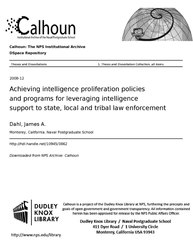File:Achieving intelligence proliferation policies and programs for leveraging intelligence support to state, local and tribal law enforcement (IA achievingintelli109453862).pdf

Original file (1,275 × 1,650 pixels, file size: 406 KB, MIME type: application/pdf, 98 pages)
Captions
Captions
Summary[edit]
| Achieving intelligence proliferation policies and programs for leveraging intelligence support to state, local and tribal law enforcement
( |
||
|---|---|---|
| Author |
Dahl, James A. |
|
| Title |
Achieving intelligence proliferation policies and programs for leveraging intelligence support to state, local and tribal law enforcement |
|
| Publisher |
Monterey, California. Naval Postgraduate School |
|
| Description |
The need to proliferate intelligence to all appropriate levels of society is an imperative that has been all to vividly illustrated by the attacks of 9-11. Terrorism cuts across all levels of society through loss of life, economic chaos and inhibiting freedoms. The horrific loss of life cannot be minimized or discounted, but the damage goes further and its effects are enduring. Estimates of the future economic impact of terrorism, based on 9-11 losses, range from 100 million to 100 billion dollars per year. These numbers don't quantify the emotional toll or the self-imposed loss of personal freedom that attacks the very nature of democracy. The prolific nature of terror calls for an equally prolific response. This thesis has argued that in order to proliferate the intelligence, that will connect the dots and mitigate future terror attacks, all aspects of the intelligence enterprise must leveraged to form a collaborative intelligence community that includes federal, state and local law enforcement as well as private sector partners. The policies and programs examined identify information sharing as the chief enabler of leverage. The premise is that the more information shared the more intelligence is produced. This positive relationship drives the concept of intelligence proliferation. Subjects: Intelligence service; United States; Terrorism; Prevention; Government policy; National security; Information technology |
|
| Language | English | |
| Publication date | December 2008 | |
| Current location |
IA Collections: navalpostgraduateschoollibrary; fedlink |
|
| Accession number |
achievingintelli109453862 |
|
| Source | ||
| Permission (Reusing this file) |
This publication is a work of the U.S. Government as defined in Title 17, United States Code, Section 101. Copyright protection is not available for this work in the United States. | |
Licensing[edit]
| Public domainPublic domainfalsefalse |
This work is in the public domain in the United States because it is a work prepared by an officer or employee of the United States Government as part of that person’s official duties under the terms of Title 17, Chapter 1, Section 105 of the US Code.
Note: This only applies to original works of the Federal Government and not to the work of any individual U.S. state, territory, commonwealth, county, municipality, or any other subdivision. This template also does not apply to postage stamp designs published by the United States Postal Service since 1978. (See § 313.6(C)(1) of Compendium of U.S. Copyright Office Practices). It also does not apply to certain US coins; see The US Mint Terms of Use.
|
 | |
| This file has been identified as being free of known restrictions under copyright law, including all related and neighboring rights. | ||
https://creativecommons.org/publicdomain/mark/1.0/PDMCreative Commons Public Domain Mark 1.0falsefalse
File history
Click on a date/time to view the file as it appeared at that time.
| Date/Time | Thumbnail | Dimensions | User | Comment | |
|---|---|---|---|---|---|
| current | 20:51, 13 July 2020 |  | 1,275 × 1,650, 98 pages (406 KB) | Fæ (talk | contribs) | FEDLINK - United States Federal Collection achievingintelli109453862 (User talk:Fæ/IA books#Fork8) (batch 1993-2020 #5127) |
You cannot overwrite this file.
File usage on Commons
The following page uses this file:
Metadata
This file contains additional information such as Exif metadata which may have been added by the digital camera, scanner, or software program used to create or digitize it. If the file has been modified from its original state, some details such as the timestamp may not fully reflect those of the original file. The timestamp is only as accurate as the clock in the camera, and it may be completely wrong.
| Author | dlcuadre |
|---|---|
| Short title |
|
| Date and time of digitizing | 03:35, 20 January 2009 |
| Software used | PScript5.dll Version 5.2.2 |
| File change date and time | 03:35, 20 January 2009 |
| Conversion program | Acrobat Distiller 8.1.0 (Windows) |
| Encrypted | no |
| Page size | 612 x 792 pts (letter) |
| Version of PDF format | 1.4 |

